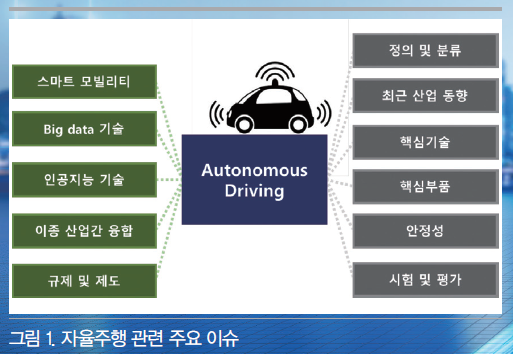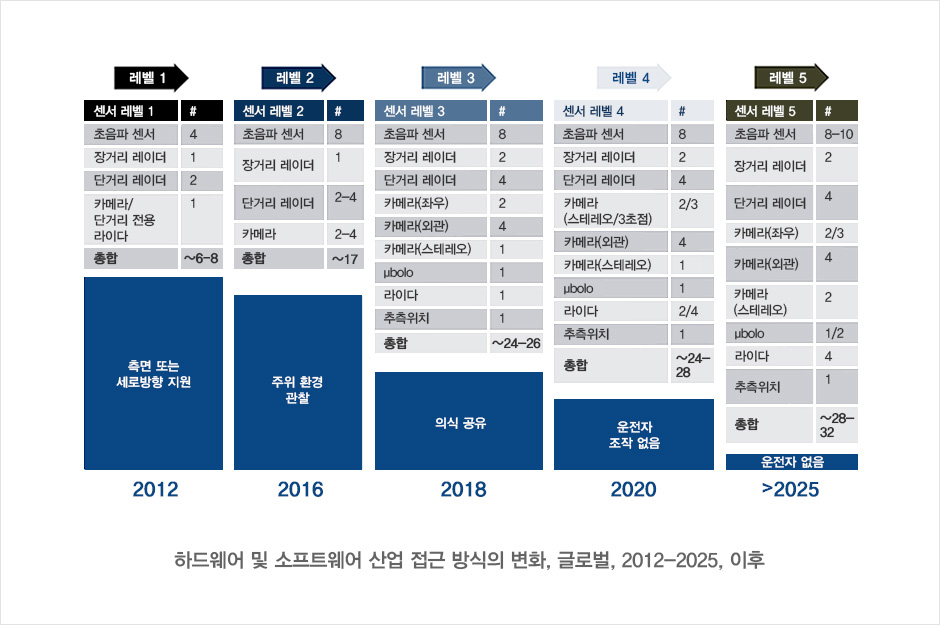Professor Chung Ho-ki of Expressway C-ITSby, Department of Electronic and Electrical Engineering, University of Transportation for Practical Self-Driving

How do you view the disillusionment of self-driving?

How do you view the disillusionment of self-driving?

As media reports on self-driving cars, which have been mentioned as synonymous with the 4th Industrial Revolution for a while, are decreasing, public interest is gradually cooling down. In particular, people are tired of the sluggish performance of robotaxi, and some even say that it is “autonomous disillusionment.”[1]. Are self-driving cars really going to be a useless dream? Or will he return spectacularly as the spearhead of the Fourth Industrial Revolution? The current situation is easily understood from the perspective of the Gartner type graph. Hype cycle is a method of explaining the cycle of technology growth in five stages [2]. In other words, until some technology is born and located in our lives, it goes through five stages: 1) technology inspiration, 2) peak of inflated expectations, 3) disillusionment, 4) enlightenment, and 5) productivity stability. Looking at self-driving cars from this perspective, since 2010 when Google announced that it was experimenting with driving in the city with self-driving cars [3] It can be seen that the inflated expectations that have continued for more than a decade have passed the peak and entered the stage of disillusionment. The description of the disillusionment phase of the hypocycle provides an accurate description of the current situation of self-driving cars.”The failure of experiments and implementations to produce results diminishes interest. Those who try to commercialize them give up or fail. Investment will only continue if the surviving business entity succeeds in improving products that satisfy consumers.” [3]Here, it can be seen that the reason for self-driving disillusionment is a lack of practical performance and dissatisfaction with consumer expectations. On the other hand, it can be seen that if the company can proceed to the productivity stabilization stage through the current disillusionment stage, the surviving business can become a major player in the full-fledged autonomous driving market.

Expressways will emerge as the main driver of self-driving cars.

Expressways will emerge as the main driver of self-driving cars.

The era of receiving investment with the title of self-driving is over, just like the inflated expectation stage. So what do we need to make a direct economic profit from self-driving? Promoting the convenience of drivers through self-driving is also a great achievement, but it does not directly benefit the economy. Improving safety will lead to a reduction in insurance premiums and a reduction in accident compensation costs, but there is a strong indirect aspect. In order to achieve a clear and direct economic benefit, it seems that drivers must be able to save labor costs. In the case of private passenger cars, convenience and safety of drivers can be improved, but labor costs are not saved. Self-driving taxis are not yet fully completed to be completely unmanned. In order to introduce autonomous driving to private passenger cars or taxis, it must be possible to drive autonomously even in complex cities, so expensive environmental recognition sensors and computers must be installed. While the introduction cost is so high, the direct economic benefits of the current business model, which cannot save labor costs, are bound to be limited. Therefore, it has been difficult for self-driving cars to succeed in business. Considering the lack of technical completeness to achieve driverless autonomous driving in complex cities, shuttle and highway freight transportation are considered to be areas where autonomous driving can generate direct economic benefits in the near future. The shuttle is a vehicle that runs only on a fixed route and can be used at airports, tourist spots, transfer stations, and farming and fishing villages (community buses). This driving environment is significantly less difficult than autonomous driving in the city center, so it can be predicted that unmanned driving is possible or only driving assistants are required. Expressways are also significantly less difficult, and many companies are already mass-producing highway driving assistance systems. In particular, attention is focused on expressway freight transportation because commercial vehicles are the main means of freight transportation in major European countries such as Germany, France, Spain, and the Netherlands. Commercial vehicles are responsible for about 70% of all cargo transportation in Europe. The situation in the U.S. and China is not much different [4]. Considering the size of the market, it can be expected that expressway commercial vehicles have much greater direct economic benefits of autonomous driving than shuttles. Therefore, autonomous driving of expressway commercial vehicles is emerging as a key driving force for autonomous driving development.

Level 50,000 self-driving and smart roads are needed.

Level 50,000 self-driving and smart roads are needed.

Level 50,000 self-driving and smart roads are needed.

It is necessary to introduce lanes and roads exclusively for self-driving cars.

It is necessary to introduce lanes and roads exclusively for self-driving cars.

Automatic Operation of Transfer Hubs and Expressways[4]

In the United States, 20 to 25 percent track transportation is expected to be carried through the switching hub.According to consider the amount of transport costs from 30 to 50 percent of transport costs, the transportation hub is expected to save 40 percent of transport costs.The U.S.Embark company started transporting business.If the driver is still boarding, the driver is expected to be able to change the unmanned traveling, it is expected to easily change the unmanned traveling.

In the United States, 20-25% of trucking is expected to take place via a transfer hub by 2035. [9]. Considering that driver costs account for 30-50% of transportation costs, freight transportation using transfer hubs is expected to save 40% of transportation costs. Embark in the U.S. has already started a transportation business using a transfer hub [10]. Although the driver is still on board, it is expected to easily switch to unmanned driving if roads or lanes exclusively for self-driving are secured.

Finish: Who’s going to pay?

Finish: Who’s going to pay?

The following is a summary of what has been said so far.1) Expressway self-driving must be handled separately in three and five stages. It is realistic to introduce a self-driving-only road or a dedicated lane for the fifth stage, and prepare for no problems with the operation of the third stage on the general expressway.2) Vehicles using self-driving roads or private lanes will save labor costs, so a significant portion of the profits generated will be paid for road usage. Therefore, it is necessary to develop a business model through active private capital attraction.3) In operating the third stage of self-driving on general expressways, the method of using only vehicle-mounted sensors has many restrictions on the recognition of the driving environment, so active introduction of C-ITS technology is necessary. Automatic control can be linked, but notifying the driver of the front accident or road condition through the in-vehicle terminal can prevent quite a few accidents. In particular, multiple rear-end collisions and fire accidents in tunnels, which have emerged as social anxiety factors in recent years, multiple rear-end collisions due to road thin ice, and multiple rear-end collisions on bridges due to fog occur in restricted areas. By first applying the part where you can feel the effect urgently like this, you will be able to improve the installation rate of the terminal and build up the justification for mandatory installation.4) The problem is that applying the third stage of self-driving to all expressways cannot raise tolls on the grounds of this. Although huge investment is needed in the installation and management of road facilities for the third stage of self-driving, there seems to be no other way but the government’s investment. The government will be able to explain the necessity and effect directly, but ultimately it should draw public awareness and sympathy for C-ITS. For this reason, it is necessary to create a change that current drivers can experience, not a grand vision for the future too far away.

※ ※ 작가의 개인 의견으로 작성되었습니다.※ ※ 참고 자료[1]The Metric Map key, “The automatic driving industry will go to the fast road, after the robot taxi, https://www.ft.com/content/96d3eeff-7f52-46e3-a8a8-aeb668472034 [2] 위키백과、「하이프 사이클」、2021年5月19日 https://ko.wikipedia.org/wiki/%ED%95%98%EC%9D%B4%ED%94%84_%EC%82%AC%EC%9D%B4%ED%81%B4 [3] ジョン·マルコフ、「Google Cars Drive Theselfs, In Traffic」、201年10月9日 https://www.nytimes.com/2010/10/10/science/10google.html [4]Consultancy.eu , “Track trends: Automation and digitalization and digitalization” https://www.consultancy.eu/news/1970/trends-in-trucking-self-driving-trucks-electrification-and-digitalisation と Cérenzier, 2018年10月15日,We need to have better roads and infrastructure.” 2018年8月14日 https://hbr.org/2018/08/to-make-self-driving-cars-safe-we-also-need-better-roads-and-infrastructure [7] Dacia J.”The automatic driving car lane comes to the automatic driving lane:They help themselves to help the progress of five governments?” 2020年8月16日 https://www.teslarati.com/tesla-full-self-driving-lanes-help-hinder-level-5-autonomy/https ://www.michiganbusiness.org/press-releases/2020/08/michigan-cavnue-creating-road-of-future-between-ann-arbor-and-detroit/ [8]Synchronization, “The Beijing will build a 100 km fast road on August 31, 2018” on August 31, 2020 and https://www.trucks.com/2018/09/05/long-haul-driverless-trucking-would-displace-good-paying-jobs-study-says/ [9] “Have the long distance driver’s career driving car,On September 25, 2019 “The automatic driving startup will raise $7,000 million and launch https://www.forbes.com/sites/alanohnsman/2019/09/25/self-driving-startup-embark-raises-70-million-opens-freight-hubs-for-robot-big-rigs/ for freight transport robot 3 to open the cargo transport robot 3.”

※ 작가의 개인 의견으로 작성되었습니다.※ 참고 자료[1] Patrick McKee, “The Self-Driving Industry Goes to the Expressway After Robot Taxi Failure,” July 20, 2020 https://www.ft.com/content/96d3eeff-7f52-46e3-a8a8-aeb668472034 [2] 위키백과、「하이프 사이클」、2021年5月19日 https://ko.wikipedia.org/wiki/%ED%95%98%EC%9D%B4%ED%94%84_%EC%82%AC%EC%9D%B4%ED%81%B4 [3] ジョン·マルコフ、「Google Cars Drive Theselfs, In Traffic」、201年10月9日 https://www.nytimes.com/2010/10/10/science/10google.html [4] Consultancy.eu , “Track Trends: Electricalization and Digitization of Self-Driving Trucks” https://www.consultancy.eu/news/1970/trends-in-trucking-self-driving-trucks-electrification-and-digitalisation と Cérenzier, 2018年10月15日, We also need better roads and infrastructure.” 2018年8月14日 https://hbr.org/2018/08/to-make-self-driving-cars-safe-we-also-need-better-roads-and-infrastructure [7] Dacia J. Ferris said: “A self-driving car lane is coming: Do they help or hinder the progress of level 5 autonomy?” 2020年8月16日 https://www.teslarati.com/tesla-full-self-driving-lanes-help-hinder-level-5-autonomy/https ://www.michiganbusiness.org/press-releases/2020/08/michigan-cavnue-creating-road-of-future-between-ann-arbor-and-detroit/ [8] At the same time, “Beijing will build a 100km highway for self-driving cars with unmanned machines,” August 31, 2020 https://syncedreview.com/2020/08/31/beijing-builds-100km-highway-lanes-for-self-driving-cars-with-unmanned-machineries/ [9]Alan Adler, “Long-distance driverless trucks will replace high-paying jobs,” September 5, 2018 https://www.trucks.com/2018/09/05/long-haul-driverless-trucking-would-displace-good-paying-jobs-study-says/ [10]Alan Oonsman,September 25, 2019: Self-driving startup boarding raises $70 million and opens https://www.forbes.com/sites/alanohnsman/2019/09/25/self-driving-startup-embark-raises-70-million-opens-freight-hubs-for-robot-big-rigs/ for freight transport robot 3, 645
























